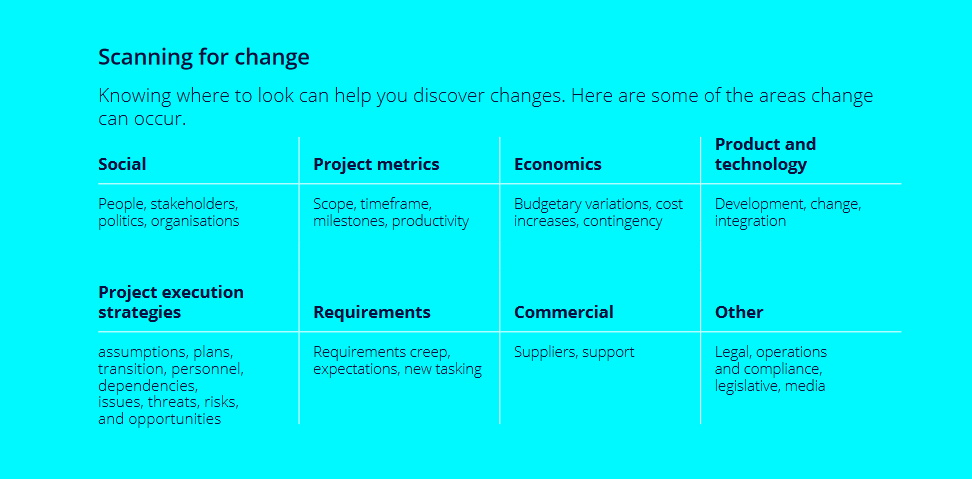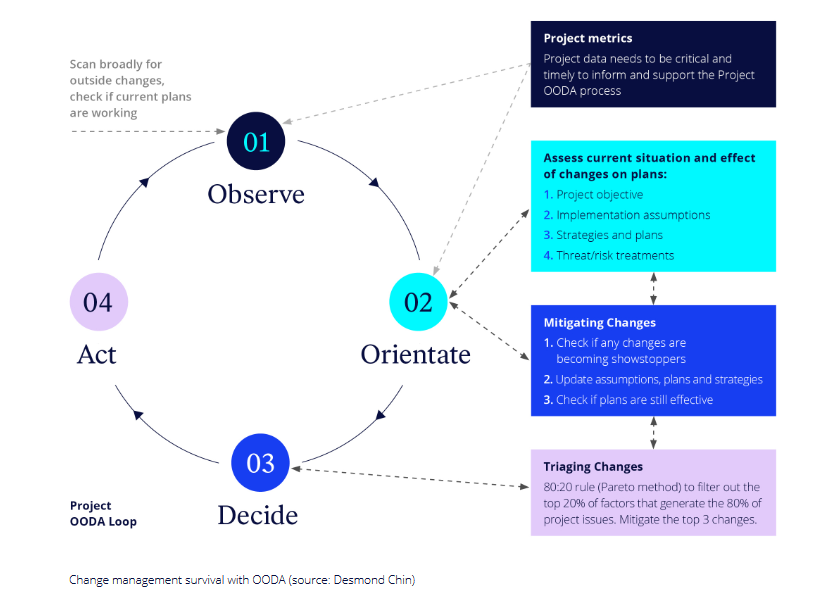

Share
What can project managers learn about change management from an old frog fable? Plenty, as it turns out. Desmond Chin FAIPM CPPD shares his perspective on managing project change, including tips on using a decision model called the OODA Loop as an adaptive framework.
There is a frog fable that says you can slowly boil a frog alive by gradually increasing the water temperature around it. The frog fails to detect and understand this change until it’s too late. The frog can’t or won’t get out of the steaming hot water, and alas, it dies.
This old tale, as gruesome as it is, interestingly has some lessons for project managers.
- Pay attention: the frog may have failed to detect the temperature change in its environment because it was too distracted by other thoughts or responsibilities.
- Understand risk: if the frog did notice the temperature change, it failed to realise it was becoming dangerous.
- Consider contingencies: the frog hadn’t planned out escape routes.
- Know when to react: unfortunately, the frog failed to identify the right temperature and time to jump, resulting in its untimely demise.
Are you smarter than a frog?
Let’s now imagine you, a highly evolved and intelligent project manager, standing in your own murky pond called the project environment when you detect a change. Would you make better survival decisions and actions than our doomed frog? It might depend on whether you:
- Can detect and understand changes in the project environment
- Know which changes are the most dangerous to your project
- Have change response plans in place
- Know which plan will best mitigate the change
- Know the conditions to launch the revised plan

Perceiving and understanding change – how hard can it be?
Detecting change is only half the battle. You also need to understand change and how it impacts a project which can be complex. Just because you can see change doesn’t mean you understand it or know what to do about it.
For example, some project teams have an overreliance on earned value data to forecast adverse changes. Getting alerts for a serious budget or schedule variance is one thing, but you also need to understand the causes, the impact and the best way to mitigate it. Follow-on analysis is required to get the complete picture.
Project managers need to be also aware that change can be missed through personal bias or blind spots that derive from being unable to detect changes due to societal aspects (such as people’s resistance to change, politics and internal and external influences), and personal biases and preferences (shaped by our personality, professional background, experience, and relationships).
How to analyse changes
When changes are detected, further analysis is required to fully understand and inform decisions.
- Extrapolation: See how change can propagate itself using what-if and brainstorming techniques.
- Showstoppers: Identify changes that are project killers and need to be mitigated.
- Opportunities: Identify changes that could help enhance the success of a project and need to be embraced.
- Triage: Prioritise changes and focus on the top three using a triage system or the Pareto 80:20 rule.
OODA change management framework
For time-poor project managers trying to make sense of the myriad of changes in your project environment, below is a simple process that might help.
The suggestion is to adapt the OODA Loop (Observe, Orientate, Decide and Act) decision making model developed by Air Force Colonel John Boyd to help fighter pilots survive air-combat. Fighter pilots exist in an extreme change management environment. Pilots must detect the enemy, analyse their actions, develop change response options, decide how and when to act and then action their new reaction plan, all within extremely short timeframes. Missteps can be fatal.
The OODA Loop is just as valuable for the more sedate world of project management. Here’s how to use it as a framework for managing project change.
- Observe: Develop your situational awareness by looking outwards and into your project environment, detect changes, and discern its characteristics. Make use of project data, project risk assessments and engagement with stakeholders to get change warnings. Highlight project showstoppers. Prevent change blindness and do not become mesmerised and distracted with data. Triage the top 3 changes.
- Orientate: Analyse the impact of changes to your current situation and identify what courses of action are now required for the project to continue to be successful. Extrapolate how changes will impact the project, and what needs to happen to mitigate these changes. Develop change response options, review existing project plans for their suitability to mitigate showstopper changes and adapt or replace plans as required.
- Decide: Evaluate your change response options and decide on your course of action and the right conditions to implement. Detail the selected course of action including its critical success factors so you can later verify if the selected course of action actually works.
- Act: Implement the selected course of action, check if selected course of action is being successful. The OODA Loop is an agile decision making process so adapt the use of OODA as changing circumstances dictate.

A framework only goes so far
Change is ever-present in the project environment, so project managers need to be capable of dealing with it. The OODA model gives you an agile framework, but you need to adapt your use of OODA as changing circumstances dictate and be agile too. Even more importantly, you need cognitive input, judgement, action, and personal agility to deal with change and help you and your project win and survive.
Notwithstanding all the above, using OODA is about giving you a framework to help you and your project win and survive – in doing so, then for another day you’re still smarter than the frog.
This article is taken from the Autumn 2023 edition of Paradigm Shift
What level of project professional are you?
Take our quick self-evaluation quiz to assess your project experience and help you determine your certification level.




